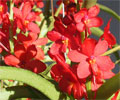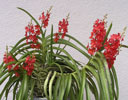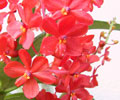|
|
|
|
|
| |
Flasks of
Ascocentrum curvifolium 'Whiskey Creek' × 'Harvest Moons' |
|
| |
|
|
| |
|
|
Click to Enlarge

Pod Parent Flowers |
Click to Enlarge

Pod Parent Blooming Plant |
Click to Enlarge

Pollen Parent Flowers |
|
|
|
| |
Culture Notes from Donor: Parent plants: Temperature range W (70-90°F)
Comments: Pod parent plant: Medium-sized plant. Puts on a wonderful show every year in the mid to late spring.
Pollen parent plant: Medium-sized plant.
For additional origin/habitat information supplied courtesy of
Charles and Margaret Baker, see further below, near the bottom of this page.
|
Temperatures we attempt to use in the lab & greenhouse:
| For Species: |
|
Spring, Summer, Autumn: days average 89°F, nights 75°F; best fit is Warm 90-70°F
(Source:
Baker's Web OSC) |
| For Species: |
|
Winter: days average 87°F, nights 57°F; best fit is Intermediate 83-60°F
(Source:
Baker's Web OSC) |
|
About the name...
| Etymology of |
Ascocentrum |
|
From latinized Greek "askos" hose; "kentron" spur. For the lip spur.
(Source:
Mayr & Schmucker 1998) |
| Etymology of |
curvifolium |
|
From Latin "curvi-" bent, crooked; "folius" leaves.
(Source:
Mayr & Schmucker 1998) |
| Pronunciation of |
Ascocentrum |
|
as-koe-SEN-trum
(Source:
Hawkes 1978) |
| Pronunciation of |
curvifolium |
|
kur-vi-FOE-lee-um
(Source:
Hawkes 1978) |
|
If you would like to direct someone to this web page, please copy and paste this URL into your email:
http://troymeyers.com/d?014648
| Flask Information |
| Availability: |
We have sold all of the flasks for this item. |
| You should: |
Consider getting individual plants or compots instead of a flask.
You can place a "Notify Flask Recipients" Request, and either we or a flask recipient may contact you when plants are available.
You may also place a "Notify Retries" Request, and if an identical pollination (the same parents) is done again, we'll let you know.
You may reserve a flask, but it's very unlikely you'll get one ...this could only happen if we found a flask that we didn't know we had. |
| Yield Estimate: |
60 plants (based on flask surveys done 12/27/2005 through 02/23/2006)
|
| Plantlet Sizes: |
From many flasks 15 - 45 mm plants (based on flask surveys done 12/27/2005 through 10/13/2006)
From one most recently surveyed flask 15 - 30 mm (10/13/2006)
|
|
You might also want to:
|
View the seed assay for this item.
View items of the same species.
View items of the same genus.
|
| Ordering Information |
| You are not currently logged in. |
|
You must be a registered user and be logged in to reserve a flask or place a notification request. Please log in:
|
|
|
|
|
|
| |
The origin/habitat information below is supplied courtesy of Charles and Margaret Baker
The following information is based on the name of the plant provided by the donor, and assumes that the name is correct. If the plant has been misidentified, then the following information may not be correct.
This text is copyrighted by the Bakers and may not be reproduced without permission.
ORIGIN/HABITAT: Burma and Thailand. In Burma, this orchid is reported
along the Attran River in Tenasserim, near Moulmein, and near Tavoy. In
Thailand, distribution is generally limited to the deciduous forests in
the mountains along the Burmese border in western and northern Thailand.
Plants are reported near Mae Hong Song, Chiengmai, and Mae Sot. Habitat
elevation was not reported with these collections, but Kamemoto and
Sagarik (1975) indicate that plants grow well in the city of Chiengmai,
and we have used this as a ball-park value for estimating the elevation of
the habitat. Plants are also reported in northeast India and from several
locations in southern Thailand. Seidenfaden (1988), however, indicates
that these reports are probably incorrect and feels that this species is
limited to a rather small area of the Tenasserim Range in Burma and
Thailand between 14 and 18N latitude.
More about this information and the Bakers...
|
|
|
| |
|
|
|